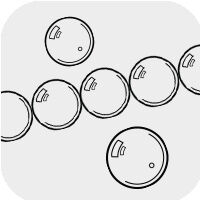Pinolith
Meaning and Properties
Pinolith History
Pinolith (pine stone), or Austrian pinolith, is a very rare semi-precious stone. Named for its magnesite inclusions resembling white pine cones or kernels (pine nuts), pinolith is also known as pinolite, pinolitstein or in German, märbelstein. Pinolith shows a matrix radiance ranging from gray to black.
It comes from only one place in the world, a magnesite deposit located in Lower Tauern, a mountain range of the Central Eastern Alps in Austria, where pinolith was discovered in 1873.
Pinolith was mined during World War II for its high manganese content--essential to iron and steel production.
Pinolith Metaphysical Properties
Pinolith is believed to be a gemstone of optimism and balance, providing a soothing, calming effect, improving self-esteem while establishing equilibrium between emotions and intellect. Pinolith is thought to promote imagination and creativity by banishing negativity and encouraging clarity of mind for positive visualization. Metaphysical adherants credit pinolith with helping them attain the highest state of meditation, finding it a useful aid for relaxation.
Pinolith is believed to activate the crown chakra and open the heart chakra to sincere love. It conducts energies that turn on the third eye. Pinolith is aligned with the astrological sign of Aries.
Pinolith Geological Properties
Pinolith is a metamorphic rock containing magnesite as white crystals in a gray dolomite and graphite matrix. While dolomite and magnesite can be found in many locations around the world, this unique combination can be found only in Styria, a state within southeastern Austria. It's German name, märbelstein, refers to the gemstone's unique marbled appearance.
|
|
|
|
|
|
|
|
|
|
|
|
|
|
|
|
|
|
Proper Care of Pinolith
Because magnesite is one of its components and has similar hardness, pinolith is easily scratched, so special care should be taken in cleaning and storing this stone. Use water and a soft cloth to safely clean. Storing in a drawstring bag is a quick-and-easy way to protect the stone from scratches. It is not recommended to use ultrasonic and steam cleaning on pinolith.
To learn more about pinolith and other gemstones, order your copy of Walter Schumann's revised and expanded edition of Gemstones of the World.
Designing with Pinolith
The white and black opaqueness of Austrian pinolith makes it ideal for creating a classic look of sophistication when matched with polished or antiqued sterling silver. Pinolith's black matrix can be further emphasized in conjunction with black gemstones such as jet, onyx, black jasper and black obsidian. Pinoilith's primary natural neutral hues of white and black make it a "universal donor" that makes it a great accent for a wide of range of colorful gemstones.
View more resources featuring pinolith, including Design Ideas, Videos, Tutorials and more!
Shop for Pinolith
**Please note that all metaphysical or healing properties listed are collected from various sources. This information is offered as a service and not meant to treat medical conditions. Fire Mountain Gems and Beads® does not guarantee the validity of any of these statements.
How did you like this resource? Your feedback helps us provide resources that matter to you most.
Copyright Permissions
All works of authorship (articles, videos, tutorials and other creative works) are from the Fire Mountain Gems and Beads® Collection, and permission to copy is granted for non-commercial educational purposes only. All other reproduction requires written permission. For more information, please email copyrightpermission@firemtn.com.

